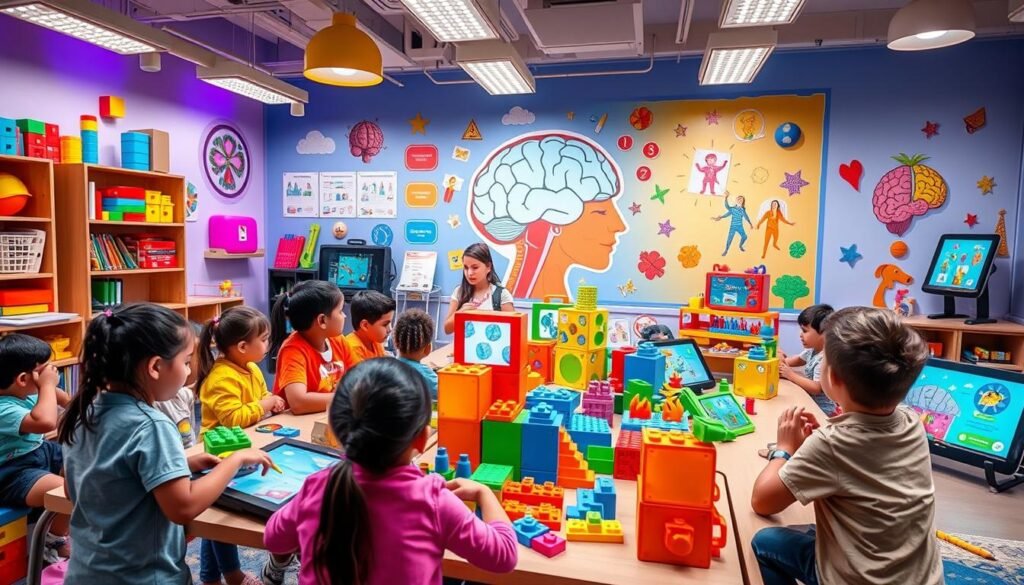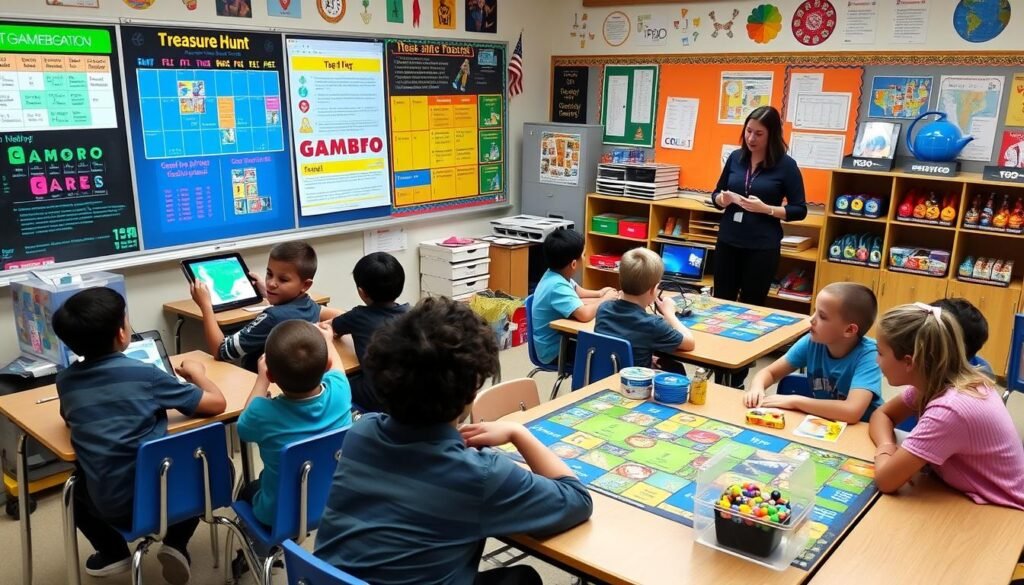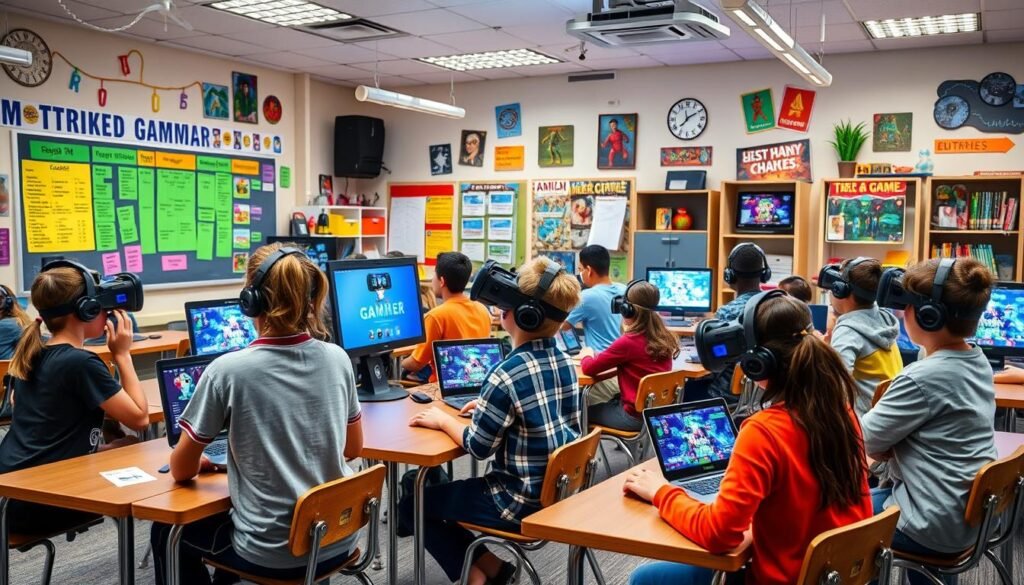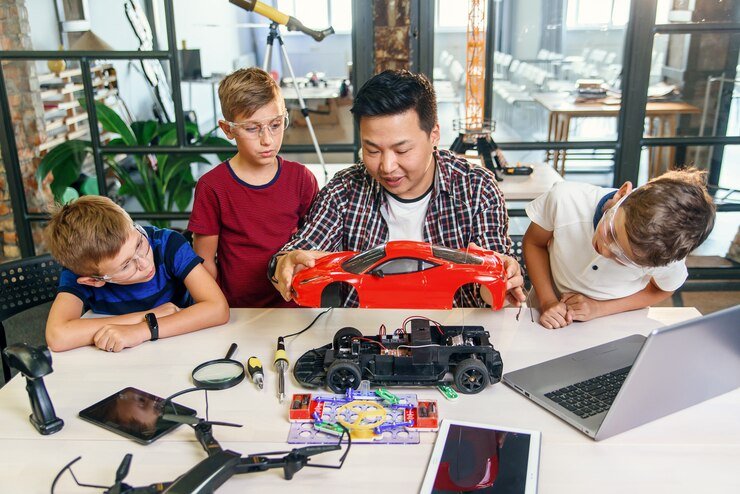Gamification has changed education by adding game elements to learning. It turns classrooms into exciting places where students love to learn. By using game mechanics, teachers make learning fun and engaging.
This approach boosts students’ motivation and helps them grow. It also lets them learn in their own way and work together on projects. These experiences go beyond just sitting in a classroom.
Key Takeaways : Gamification In Education
- Gamification has been adopted by 50% of educators in the UK to enhance teaching methods.
- 85% of students show increased engagement and motivation through gamification techniques.
- 70% of teachers report significant improvements in students’ understanding of complex subjects using gamified learning.
- 30% of schools in the UK have implemented gamification across various subjects.
- 95% of teachers observed a boost in students’ problem-solving skills after integrating gamification into the curriculum.
What is Gamification in Education?
Gamification in education means adding game-like features to learning. This includes points, competition, and rules. Teachers use these game mechanics to make lessons fun and engaging.
Infusing Elements of Games into Learning
Gamification uses interactive quizzes and games to make learning fun. It taps into our love for achievement and social interaction. This approach boosts motivation and participation in the classroom.
Some common gamified classroom elements include:
- Point scoring systems
- Leaderboards and progress tracking
- Badges, achievements, and virtual rewards
- Timed challenges and competitive play
- Personalized learning paths and choice-based activities
Teachers use these game mechanics in education to create an engaging learning environment. Students become more involved, work together, and take charge of their learning.
| Benefits of Gamification in Education | Challenges of Gamification in Education |
|---|---|
| Increased student motivation and engagement | Effective design and implementation requirements |
| Personalized learning experiences | Evaluation of learning outcomes |
| Collaborative and social learning opportunities | Ensuring accessibility and inclusivity |
| Development of critical thinking and problem-solving skills | Maintaining a balance between fun and learning |
Benefits of Gamified Learning

Gamification in education brings many benefits. It boosts student engagement and helps in cognitive development. It also leads to better learning outcomes. By adding fun and competition, learning becomes more exciting.
Research shows gamification increases classroom engagement. Students are more eager to learn and take part. Games also improve problem-solving and decision-making skills. This enhances their academic performance.
- Using gamification aids in cognitive development in adolescents, increasing brain activity and improving information processing speed.
- Some gamification methods also contribute to physical development, providing benefits akin to regular exercise.
- Gamified classrooms show increased student engagement, with research indicating higher productivity in a game-like educational environment.
Gamification is especially good for neurodiverse students. Games make learning fun and easy to follow. It also makes learning at home more fun for everyone.
“Gamification provides three thrive factors for students: immersion, achievement, and social factors.”
Gamification is a proven and effective teaching method. It has been shown to improve learning for over a century. It helps students stay engaged and do well in school.
Gamification In Education: Implementation Strategies

Teachers are finding new ways to make learning fun and effective. They use gamification, adding game elements to the classroom. This approach makes learning more engaging and exciting for students.
Interactive Activities and Role-Playing Scenarios
Interactive activities are a great way to use gamification. For example, apps like Kahoot turn quizzes into games. This makes learning fun and competitive.
Role-playing also makes learning interactive. Students can become historical figures or characters. They act out important events, which helps them understand and remember better.
There are many ways to make learning fun. Educational video games, interactive slideshows, and hands-on simulations are all options. These tools improve engagement and teach important skills like critical thinking and teamwork.
“Gamification has been proven to improve test scores and general academic performance, as the interactive and immersive nature of advanced gamification can enhance learner engagement and motivation.”
Using gamification in the classroom needs careful planning. But the results are worth it. Teachers should always look for ways to make their methods better based on what students say and what the data shows.
The online education market is growing fast. It’s expected to hit over $166 billion in 2023. Gamification in the classroom will likely become even more common. It helps students get more involved and succeed in their studies.
Immersive Learning Experiences

Gamification in education is more than just adding game-like elements. It aims to create immersive learning experiences that grab students’ attention. By mixing storytelling, game mechanics, and challenges, educators can build virtual worlds. These worlds make learning an exciting journey filled with possibilities.
These immersive learning environments push students to get involved and apply what they learn. They also spark a friendly competition that drives students to do their best. Through gamification, the classroom turns into a place of discovery. Here, students go on captivating educational adventures and gain a deep understanding of what they’re learning.
Studies have shown the great benefits of gamified learning experiences. In the US, preschoolers spend almost two days a week on screens. By 15, they spend about 4.5 days a week on screens. This shows a big interest in interactive learning experiences that keep students hooked.
Teachers are now using new technologies and game-based methods in their classrooms. Tools like Wooclap, Kahoot, and LessonUp help create immersive gamified learning experiences. They offer features like points, timers, and leaderboards. Minecraft Education Edition also supports role-playing and simulations, giving students fun, captivating educational adventures.
By using gamified learning and immersive learning technologies, teachers can get students more involved and motivated. These methods not only make learning more exciting but also teach students important skills for the future.
Also Read : Empower Your Future With A Degree In Education
Conclusion
Gamification in education is more than a trend. It’s a powerful tool that makes learning fun and engaging. By using game-like elements, teachers can create exciting learning spaces. These spaces help students stay motivated, grow their minds, and develop a growth mindset.
Gamified learning isn’t just for school. It lets students learn anywhere, anytime. As technology gets better, learning will become even more fun and personal. This will change education into a dynamic and rewarding journey.
Using gamification is key to changing how we teach and learn. It helps students get the skills and knowledge they need for today’s world. The summary of benefits of gamified learning and the future of gamified education show a bright future. In this future, learning and playing will blend together, empowering students to take charge of their own education.
FAQs
Q: What is the impact of gamification in education?
A: The impact of gamification in education can significantly enhance the learning process by using game design elements to motivate students, encourage active learning, and achieve specific learning outcomes. It bridges the gap between theory and real-world application, making learning more engaging.
Q: How can educators use gamification strategies effectively?
A: Educators can implement gamification strategies by integrating gamified activities into their curriculum, using game-based learning to align with learning objectives, and employing elements of gamification that cater to different learning styles to enhance the overall educational experience.
Q: What are some examples of gamification in education?
A: Examples of gamification in education include using points systems for completing assignments, creating leaderboards for collaborative projects, and incorporating challenge-based gamification where students must solve problems in a game-like format. These examples illustrate how educational content can become more engaging.
Q: What are the benefits of using gamification in education?
A: The benefits of gamification in education include increased student motivation, improved learning outcomes, enhanced retention of information, and the ability to cater to various learning styles. Gamification also provides real-world applications for theoretical concepts, making learning relevant and exciting.
Q: How does gamification of learning encourage students?
A: The gamification of learning encourages students by creating a sense of achievement through rewards, fostering competition, and providing immediate feedback. This approach can make the learning journey more immersive and enjoyable, thus motivating students to engage more deeply with the material.
Q: What role do gaming elements play in educational gamification?
A: Gaming elements such as challenges, rewards, and levels play a crucial role in educational gamification by making learning more interactive and enjoyable. These elements help create a structured environment where students can actively participate in their learning process and achieve their educational objectives.
Q: Can gamification improve language learning?
A: Yes, the use of gamification in language learning can improve student engagement and retention. By incorporating game design elements into language exercises, educators can create fun and interactive lessons that motivate students to practice and use the language in real-world contexts.
Q: What are some challenges in implementing gamification in education?
A: Some challenges in implementing gamification in education include ensuring the alignment of gamified activities with learning objectives, managing varying levels of student engagement, and providing adequate resources for game design. Educators need to carefully plan to maximize the educational benefits of gamification.
Q: How can gamification strategies enhance learning outcomes?
A: Gamification strategies can enhance learning outcomes by making the educational content more engaging and relevant, encouraging collaboration among students, and promoting a deeper understanding of the material. By incorporating game elements, students are more likely to retain information and apply it effectively.

